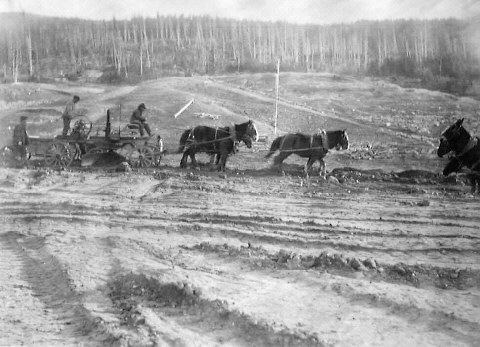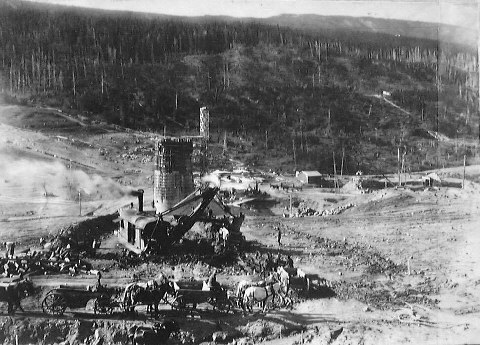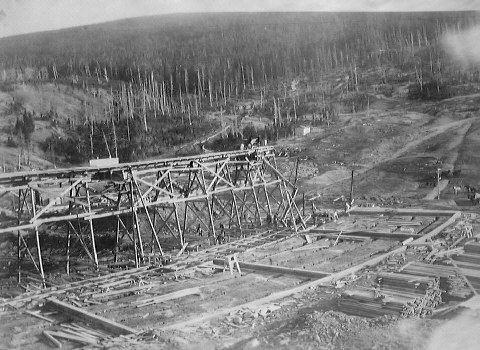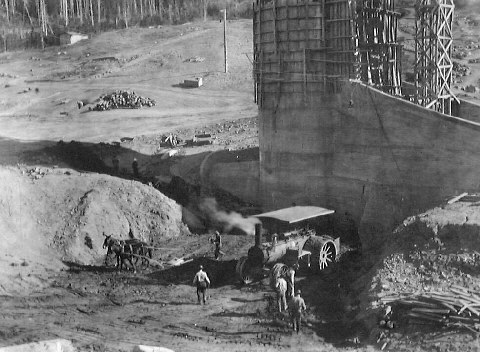- Reclamation
- Missouri Basin and Arkansas-Rio Grande-Texas Gulf
- Multimedia
- The Building of Sherburne Dam - 1914 to 1918
The Building of Sherburne Dam - 1914 to 1918
The construction of the Milk River Project was one of the first projects conceived by the Reclamation Service in the Missouri Basin Region to bring irrigation water to the new settlers of the Milk River valley in north-central Montana.

Construction of Lake Sherburne Dam, (A larger view of the construction site with construction areas labeled) the primary storage feature of the Milk River Project, began within Glacier National Park in late June 1914. Under the original plan of development, St. Mary Lakes were to be used for storage, but investigation at the St. Mary's dam site revealed poor soil and foundation conditions that would have required significant expenditures to mitigate.

Because of the foundation problems, Reclamation engineers began to look for alternative storage sites. Investigations and surveys of the Lake Sherburne site began in late 1912, and authorization for construction of Lake Sherburne Dam by government forces was given by the Secretary of the Interior on June 6, 1914. (A larger view of the construction site with construction areas labeled)
Activities at Lake Sherburne during the 1914 construction season consisted of construction of the camp, stripping of the dam and spillway areas,
 excavations for the cutoff trench and outlet works, and some concrete placement in the outlet works and spillway chute. Activities during the
early months of 1915 were delayed by funding shortages and work was limited to equipment repairs, camp improvements, and preparations of plans and
drawings for future work. In late April, $25,000 was allotted to continue work on the dam.One problem encountered was the high cost of transporting
gravel and sand to the construction site In 1914,a screening plant was constructed at the upper end of Sherburne Lakes, about 31/2 miles from the
dam site. Materials were hauled from the screening plant by teams pulling 11/2 cubic yard dump buckets, a method which proved to be very expensive.
To solve the problem, the Reclamation Service purchased a small tug boat and several barges to transport materials over the lake. The boat was
purchased for $1,900 from a Seattle ship yard and hauled overland to the construction site. Even with the costs of the boat and the expense
incurred hauling the boat to the site, the savings over the original method proved substantial.
excavations for the cutoff trench and outlet works, and some concrete placement in the outlet works and spillway chute. Activities during the
early months of 1915 were delayed by funding shortages and work was limited to equipment repairs, camp improvements, and preparations of plans and
drawings for future work. In late April, $25,000 was allotted to continue work on the dam.One problem encountered was the high cost of transporting
gravel and sand to the construction site In 1914,a screening plant was constructed at the upper end of Sherburne Lakes, about 31/2 miles from the
dam site. Materials were hauled from the screening plant by teams pulling 11/2 cubic yard dump buckets, a method which proved to be very expensive.
To solve the problem, the Reclamation Service purchased a small tug boat and several barges to transport materials over the lake. The boat was
purchased for $1,900 from a Seattle ship yard and hauled overland to the construction site. Even with the costs of the boat and the expense
incurred hauling the boat to the site, the savings over the original method proved substantial.
Construction activities during the 1915 season were severely delayed due to poor weather conditions. Rain delayed work during much of May and June, and again in September. Due to a shortage of funds, work was confined to the outlet works and the embankment south of Swiftcurrent Creek.

Weather again caused delays during the 1916 construction season, delaying the resumption of work until March. By late April, work on the dam and outlet works had reached the point where it was possible to divert the flow of Swiftcurrent Creek through the outlet works. With the stream diverted, it was possible to begin excavations in the stream channel. Work in the stream channel was twice delayed by high water overtopping the coffer dam, first in early May, and again in mid-June. The second flood caused a one month delay.
In August 1916, a second steam shovel was brought into service. However, due to a labor shortage, it was not possible to work either shovel a double shift. In October, one shovel was shut down because no one was available to operate it.
The field construction efforts at Sherburne Lake were severely dampened by a lack of adequate workers. The contractor increased the wages of all employees with transportation expenses furnished for all new employees who stayed longer than three months. Even with these incentives, a full crew could not be secured. From July 19 to November 14, 411 men were furnished railroad and stage transportation to the job site. All of the new recruits were accompanied by Reclamation employees, however 74 men quit before reaching the job site, 67 men quit after reaching the site but before going to work. Of the first 238 men who worked that summer, 100 worked only 5 full shifts and only 67 men worked 10 or more shifts before quitting. Wages ranged from $2.38 per day for a laborer to $4.00 per day for a blacksmith. Engineers and skilled laborers were paid by the month. All employees living in camp paid 75 cents a month for board, $1.50 for lodging and bunk and $1.25 for hospital fees.

For entertainment, a 24 foot by 48 foot camp building was erected for the purpose of a social hall. Included in the hall was a player piano, phonograph, billiard table, shuffleboards, and small games. It was supplied with writing materials, newspapers, and magazines to help relieve the dullness of camp life. During the construction season of 1917, labor conditions remained poor. Sufficient manpower could not be hired to perform all of the construction tasks.
In the 1917 Project History, it was stated, not only was labor scarce but it was restless. Although there was no serious trouble on this job, still the organization known as the Industrial Workers of the World were in the majority and at several times it appeared as though trouble could not be avoided, but the leaders were invited to leave and other than rumored threats of strikes, etc., nothing happened. Foreign labor was conspicuous by its absence this season and the greater majority of these employed were American and exceptionally intelligent and surprisingly good workers.

In early October, 1917, it was noted that the spillway structure appeared to be moving. Continuous observation confirmed that the spillway structure was rising and moving sideways. The cause was traced to movement of the hillside to the north of the spillway. Efforts to stop the slide, which included draining several small lakes above the slide area and channeling surface runoff away from the effected area, proved fruitless, and the movement continued. Concrete placement in the spillway chute downstream from the crest was delayed while Reclamation engineers investigated ways to combat the problem.
By the end of 1918, the dam was essentially complete. Lake Sherburne Dam and Lake Sherburne were operated for the storage and release of project water for the first time in 1919, storing, then releasing 28,800 af of water for project lands. Minor work at the site continued for several years as shortages of funds and labor delayed placement of embankment protection and completion of the spillway chute.

